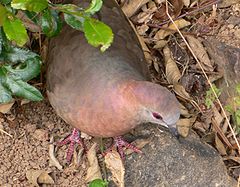- Lemon Dove
-
Lemon Dove 
Female or young male at Kirstenbosch National Botanical Garden, South Africa Conservation status Scientific classification Kingdom: Animalia Phylum: Chordata Class: Aves Order: Columbiformes Family: Columbidae Genus: Columba (disputed) Species: C. larvata Binomial name Columba larvata
Temminck, 1809Synonyms The Lemon Dove or Cinnamon Dove (Columba larvata) is a bird species in the pigeon family (Columbidae). It differs from the other African pigeons of the genus Columba by its terrestrial habits and the white face and forehead of adult males; it is therefore sometimes separated in the genus Aplopelia.[1] Some treat the Gulf of Guinea populations (São Tomé Lemon-dove) as a separate species C. simplex (or A. simplex), others as subspecies of C. larvata. In the latter case, the species as a whole may be called simply Lemon-dove, and if Aplopelia is considered a valid genus it would then be monotypic.[2]
The Lemon Dove is fairly small, measuring 24–30 cm (9.4–12 in) in length and weighing 81.7–150 g (2.88–5.3 oz).[3] Adult males have a plumage that is dark brown above, glossed green on sides of neck, and cinnamon brown below. As noted, they have conspicuous white face markings. The feet, iris and orbital skin are red, the bill is black. Females and young males are generally similar, with a lighter brown plumage and dull grey facial markings. The males of western African subspecies have a dark grey plumage.[2]
The Lemon Dove is distributed in montane forests of Africa, ranging for example from some 100 meters to 3,000 meters ASL in eastern Africa. The diet consists mainly of various small fruits, seeds, molluscs and insects. The female usually lays two creamy white eggs.[4]
Widespread throughout its range, the Lemon Dove is evaluated as a Species of Least Concern on the IUCN Red List of Threatened Species. Nonetheless, it seems to be declining in some parts of its range; in Tanzania for example it is not rare above 1.300 meters ASL in the Nguu North Forest Reserve, but not at all common in some lower-lying habitat. It is nearly absent from the southeast of that country.[5]
Footnotes
References
- BirdLife International (BLI) (2008). Aplopelia larvata. In: IUCN 2008. IUCN Red List of Threatened Species. Downloaded on 5 May 2009.
- Jensen, Flemming P.; Tøttrup, Anders P. & Christensen, Kim D. (2005): The avifauna of coastal forests in southeast Tanzania. Scopus 25: 1-22. PDF fulltext
- Seddon, N.; Ekstrom, J.M.M.; Capper, D.R.; Isherwood, I.S.; Muna, R.; Pople, R.G.; Tarimo & Timothy, E.J. (1999): The importance of the Nilo and Nguu North Forest Reserves for the conservation of montane forest birds in Tanzania. Biological Conservation 87(1): 59-72. doi:10.1016/S0006-3207(98)00041-X PDF fulltext
- Sinclair, Ian; Hockey, Phil & Tarboton, Warwick R. (2002): SASOL Birds of Southern Africa. Struik, Capetown ISBN 1-86872-721-1
External links
Categories:- IUCN Red List least concern species
- Birds of South Africa
- Columba
- Birds of Burundi
- Birds of Eritrea
- Birds of Ethiopia
- Birds of Gabon
- Birds of Mozambique
- Birds of Zambia
- Birds of Zimbabwe
Wikimedia Foundation. 2010.

